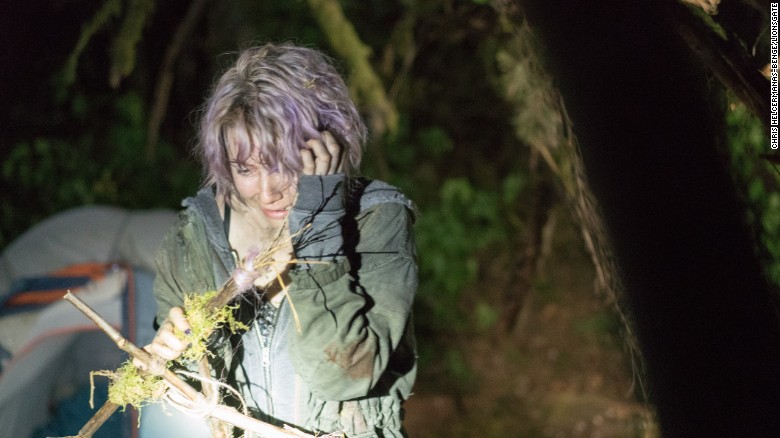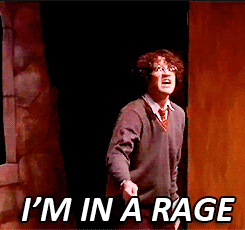Full disclosure: I am in a rage while writing this. In fact, this post was originally going to be a nice post about the unsung beauty of found footage films and all their redeeming qualities. It’s not about that anymore. The forthcoming found footage horror film The Woods was mentioned in my original draft of this post, as were its narrative elements that sounded exactly like Blair Witch. SURPRISE, KIDS, IT IS BLAIR WITCH. Turns out the very derivative-sounding film is even more derivative than we thought.
And a lot stupider.
Blair Witch, originally promoted as The Woods, follows the trail of a group of young adults who venture into the Burkitsville wilderness after one of them realizes the narrator from the original film, Heather Donoghue, is his sister. As they go searching for answers, they’re plagued by the same terrors that befell the original film crew.
GARBAGE.
Okay. I’ll simmer down now and talk analytically about why this is dumb. Because, objectively, I get it. The A.V. Club once described found footage films as the 2000s equivalent of the 80s and 90s slasher genre. And that’s true for a lot of reasons: the low production cost, the ever-spawning sequels, and the sheer unlimited plot resources centered around the trope. But standards have fallen so greatly that mentioning the phrase “found footage” in conjunction with a horror film would produce several groans and eye rolls. And for good reason. After all, with those tiny budgets, basically anyone can pitch a measly found-footage film for summer release and work at further insulting our intelligence.
The problem however, is that the original Blair Witch was, in many ways, the opposite of all that. And it proved that at the end of the day, found footage can actually accomplish a lot when executed correctly.
First of all, would you believe found footage is a lot older than you might imagine? 70s? 60s? Try the 18th century. The genre has its roots in the epistolary novel, a story written as a series of documents that the reader is experiencing secondhand. This genre first saw the light of a printing press in the 1700s. The first epistolary work of horror was 1818 with Mary Shelley’s Frankenstein. See? It’s sounding smarter already. Since then the epistolary novel has kind of fallen out of interest. The angsty YA novel Perks of the Being a Wallflower utilized it, and Mark Danielewski redefined it with his debut novel House of Leaves and subsequent series The Familiar.
Let’s fast forward. The first film to truly revolutionize the genre into something viable was 1980’s Cannibal Holocaust, an Italian film that documents the final days of a documentary crew sent into the Amazon to film local tribes after their footage is discovered by a rescue team. A couple films came out after that utilized the same technique but no one did more to completely define the genre in the modern era than The Blair Witch Project.
Like many great works of horror, by modern standards, its fear factor is a little polarizing. On the one hand you’ve got those who attest to the academic and cultural importance of the film, and others (like my sister) who walked out of the theatre (why would you walk out of a theatre?). However scary you think it is or isn’t, it is a pretty important movie. This was the first film to utilize “viral” marketing. It was the first time a film used the internet as its primary source of interest, offering curious web surfers fake police reports and documentaries about the “missing” film students in the movie and the legends they were investigating.
In fact, IMDB listed the actors as “missing/presumed dead” for the first year the film was available, and filmmakers handed out informational flyers asking for any tips on their whereabouts at early screenings. This marketing tactic resulted in crazy debates as to whether or not the movie was depicting true events or not. As late as 2011, I convinced a friend to watch the film who believed it was a true story. So, in the age of internet infancy (1999), viral marketing worked wonders. And now it’s overused and lost its luster, not unlike what happened to the found footage genre itself. This new Blair Witch maybe, sort of, tried to do something similar by hiding its true nature. But in watered down and lackluster way.
The Blair Witch Project is actually widely acclaimed, even to this day. And if accolades don’t do it for you, it is among my top five favorite horror films. The fact of the matter is, anyone can take advantage of a jump scare. It’s anatomical wiring that anyone is going to have a startle response to quick stimuli. It’s how the amygdala works. Even the most god-awful horror film can scare you with enough sudden, loud noises. But Blair Witch was devoid of jump scares and even gore. It was the fear of the unknown and the traditional “don’t show the monster” that made it so chilling. You never saw what was hunting the group of filmmakers in the woods because your imagination was far more terrifying, especially when the script expertly peppered eyewitness accounts to give you an idea of what horror was waiting just beyond the camera lens.
The film also relied a great deal on the method work of its actors. All three of them, Heather Donahue, Michael C. Williams, and Joshua Leonard, were selected from an open call of thousands of actors based on their improv work in auditions. Every scene was improvised by the actors based on instructions they received that morning. They had to find their own way through the woods (but luckily were never more than a mile from the road). Further, they had a crash course in how to handle their own cameras since the film relied completely on their POV camera work.
In short, what made Blair Witch great was its authenticity and very serious approach to what it was trying to sell. And it paid off in a big way. Of course, what immediately followed were half-baked attempts to replicate the same viral success. It even did have its own little-known sequel in 2000 that went nowhere and abandoned the POV medium. And nothing truly made any mark until Paranormal Activity.
And here we are, with a Blair Witch reboot complete with contrived storyline and familiar scares. Oh sure, they were slick in the way they went it about it, not unlike the original, with the fake name throwing people off. But that’s where the cleverness ends. And sure, I should reserve judgment until actually seeing the film, but I’ve also, as they say, seen this movie before. Blair Witch is still an ominous phrase with a lot attached to it, so making a reboot is smart. But, like all uncalled for sequels and reboots, it’s going to tarnish the memory of the original and fail to recapture its own lightning into a bottle.
In the meantime, here are some non-headache inducing found footage titles to pursue to wash out your brain:
Grave Encounters (2011): This one straddles the line between mockbuster and played-for-straight film as it follows a paranormal investigation group (totally not Ghost Adventures) as they find out a location is more haunted than it seemed.
The Houses That October Built (2014): This Netflix gem has a concept close to my heart as a group of friends travel cross-country to make a documentary on Halloween haunts before getting sucked into the a dark conspiracy.
Unfriended (2015): This one was mostly dumb, but the medium was unique and the focus on cyber bullying was pretty real as a group of friends drop off one-by-one during a fatal Skype call.
V/H/S (2012): This is an anthology series with a frame story of a man watching a series of frightening VHS tapes.
The Den (2013): This film mixes found footage with slasher as a young woman conducts a social experiment across a Chat Roulette-style dating website and finds herself stalked by an anonymous, and dangerous, internet troll.
The Bay (2012): This is a super interesting film starring a novice reporter who narrates a series of leaked footage during a Fourth of July celebration gone awry when a deadly water contagion spreads.
As Above So Below (2014): Going to be honest, I’m recommending this one solely because I loved the aesthetic and the concept of a group of Parisian “cataphiles” getting lost in the catacombs beneath the city.
REC (2007): This is the original Spanish film upon which Quarantine was based. It follows a reporter and her cameraman who find themselves, along with firemen and tenants, locked inside an apartment building as a means to contain a quickly-spreading virus.






0 comments:
Post a Comment